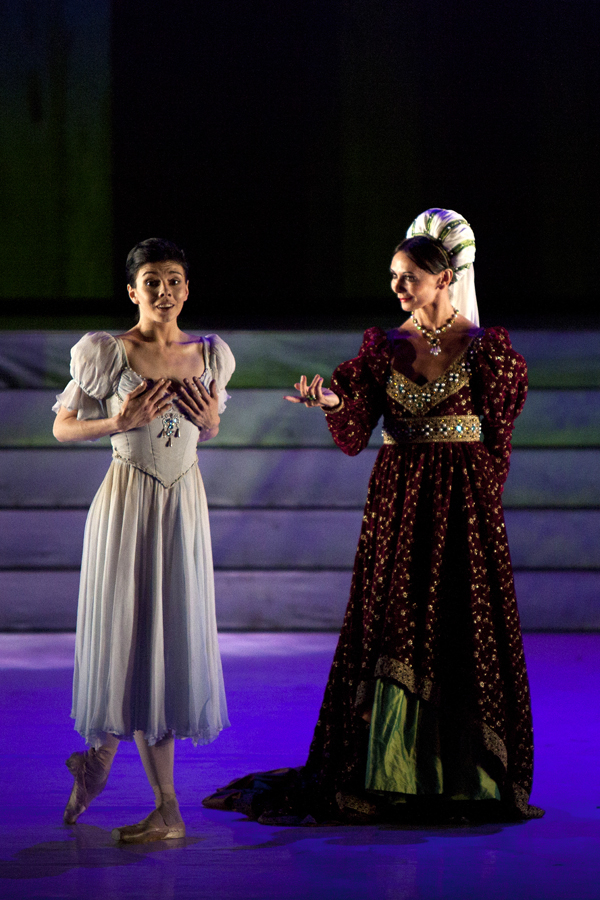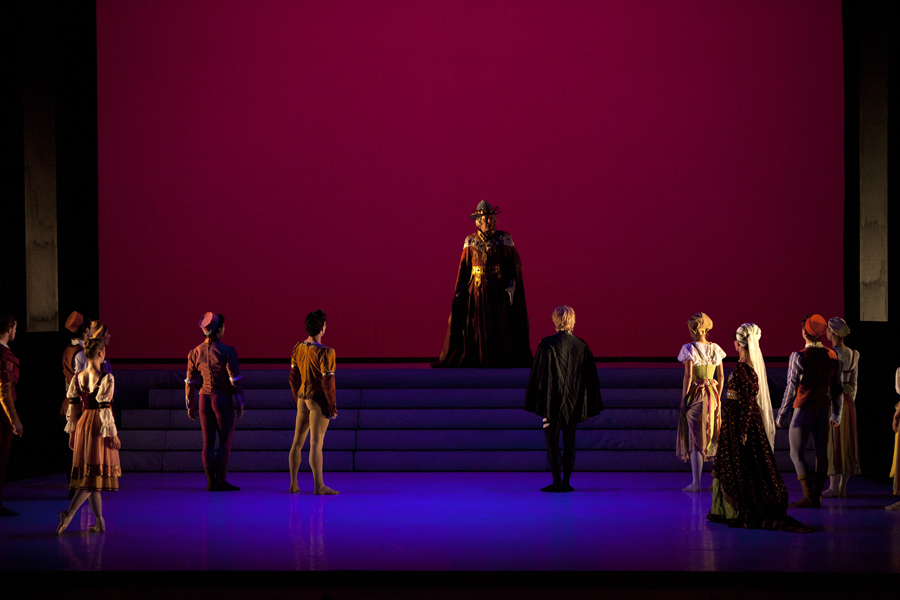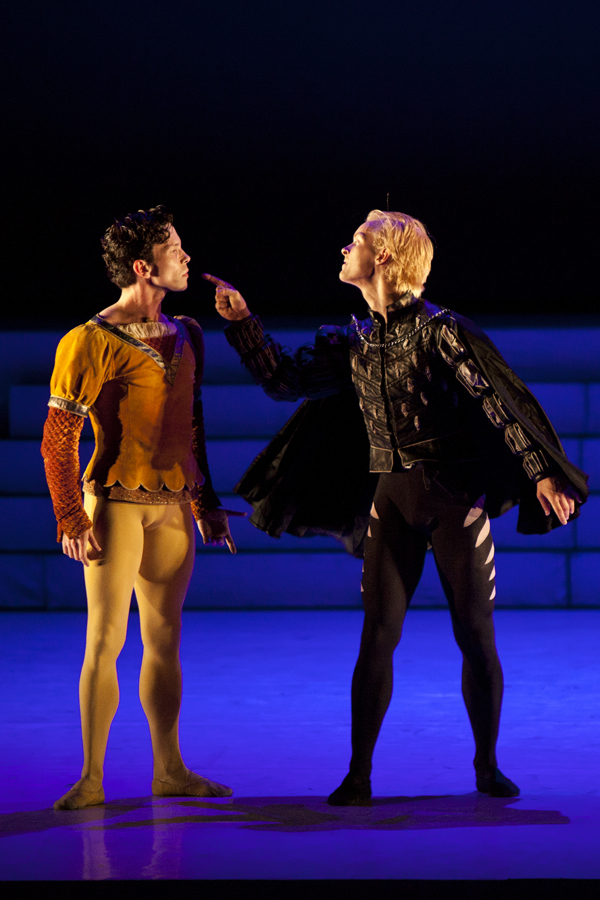Ashton's Romeo and Juliet, London Coliseum | reviews, news & interviews
Ashton's Romeo and Juliet, London Coliseum
Ashton's Romeo and Juliet, London Coliseum
Two stellar artists bring an intimate tragedy out from behind closed doors
Like planets crossing in the skies, light years apart, but by some ocular illusion coinciding, this conjunction of the two most thrilling young Bolshoi stars in the world and Frederick Ashton’s rarely staged Romeo and Juliet really must be seen. Natalia Osipova and Ivan Vasiliev are real-life lovers as well as phenomenal work colleagues and passionate actors. The freshness of youth, the unhindered outpouring of emotion, the finish of their dancing, and their direct stage personalities enrich to bursting a chamber-sized telling of the tragedy that's refreshingly intimate by comparison with the more popular blockbuster versions.
Ashton’s version predates the landmark Bolshoi visit of 1956 with their powerhouse version, which altered everything. His, made for the Royal Danish Ballet’s small theatre and their delicate, precise dancing style, is a baroque cantata in comparison to the great ensemble ballets to Prokofiev’s score that would sweep Europe after the Bolshoi trip.
Without preconceptions, he clipped the music down to fit his vision of something distilled directly from Shakespeare’s list of characters, with very spare group ensembles - it aims to be lyrical verse, not dramatic symbolism like the Bolshoi's Lavrovsky version, nor naturalistic dance prose like Kenneth MacMillan's, nor socio-political commentary, like Rudolf Nureyev's. It’s a tragedy behind closed doors.
But there was no polite restraint in Osipova and Vasiliev last night, the official opening of this week's run at the London Coliseum. He, the Bolshoi’s most lionised new Spartacus, looked initially cramped by Romeo’s opening solo - as economically graceful as a galliard, with much play with a fluttering cape. But then the curly-haired lad with wings on his heels unleashed arrow-fast jumps, burnished the dancing with Bolshoi macho (not equalled by his sword fighting, though).
 And he was so grave and careful with his girl - there was an anxious fatalism about his performance which indicated that this Romeo was slightly better attuned to the potential for disaster than Juliet. This sort of sensitive tuning is rare in some of the bigger-scale dancers, and it sets Vasiliev apart as an artist potentially to live through emotional dilemmas with, rather than just gawp at for his physical dynamism.
And he was so grave and careful with his girl - there was an anxious fatalism about his performance which indicated that this Romeo was slightly better attuned to the potential for disaster than Juliet. This sort of sensitive tuning is rare in some of the bigger-scale dancers, and it sets Vasiliev apart as an artist potentially to live through emotional dilemmas with, rather than just gawp at for his physical dynamism.
Osipova, with her gamine black crop and alabaster skin, is a world-beater too. Those few lucky enough to get into Bolshoi performances in London have seen the laughter in her dancing, the sunbeams in her leaps and spins. Again, this is not that kind of thing. Ashton’s Juliet has a whirring, beating quality that’s all about iridescent detail, not about the cosmic flight and rocketing speed that Osipova’s uniquely capable of. But she’s turned that physical bounty into sheer life force in her characterising. (Osipova pictured right with Marguerite Porter as her mother.)
She bounded with such happiness into the ball, succumbed with such giddy excitement to the blandishments of the masked Romeo, that you almost wanted to tug the child back, warn her. And this is acutely Shakespearean.
The Balcony Scene is scaled down - they stand close together touching each other, no hurtling about the stage as they do in the MacMillan - but no scaling down at all in young unrestrained rapture in these two. It’s a deeply touching pas de deux, with constantly evolving variations on embracing arms, closely winding, or spraying out in triumph, unorthodox and almost contemporary, particularly for the girl. Overall one can see why companies go for bigger, more impactful R&Js, with shorter mime scenes and striking ensembles the measure of the music, yet these softer tints gleam touchingly with such performers as these two.
Graham Bond and the ENB Orchestra provided a brisk, matter-of-fact musical performance, so I didn’t mind losing so much of the music as to keep the action to well under two hours (plus interval). Though Ashton later restored some, and made ensemble dances for the 1985 London Festival Ballet production he did with Peter Schaufuss, then LFB artistic director and star, Schaufuss has reverted to the sparer bones of the 1955 original. The one dance it hurts my memory not to see here is the pre-wedding wake-up Mandolin Dance outside Juliet’s room while she lay in her drugged stupor, the carefree entertainers underscoring the pain of the tragic misunderstandings about to take place.

More painful in Schaufuss's production is that the stage design lacks any dimensional integrity, simply shooting colour washes or black-and-white photo projections of old Italy over the back. Though mostly suitable images (apart from the nauseating red rose petals when the lovers meet - I ask you), the sense of place is much subverted by the baffling columnar neon-lightboxes either side, more contemporary hotel lobby than a setting for a medieval love story. Ashton's work is too much a period piece to look comfortable so stripped of place and time.
 While one’s eyes can’t easily be lured away from the leading pair, Schaufuss thoughtfully provides a new young Royal Danish Ballet talent, Alban Lendorf, as Mercutio, tall, affable and well built, with finely timed feet. We also see an amazing bleached-blond Goth of a Tybalt from another Dane, Johan Christensen (pictured left, with Robin Bernardet as Benvolio), in slashed black doublet and hose - his death roll down the stairs looked spectacularly bruising.
While one’s eyes can’t easily be lured away from the leading pair, Schaufuss thoughtfully provides a new young Royal Danish Ballet talent, Alban Lendorf, as Mercutio, tall, affable and well built, with finely timed feet. We also see an amazing bleached-blond Goth of a Tybalt from another Dane, Johan Christensen (pictured left, with Robin Bernardet as Benvolio), in slashed black doublet and hose - his death roll down the stairs looked spectacularly bruising.
And last night, a special gala show for the Dancer for Cancer Trust, there were extra characters on stage, the senior generation of authority figures played by a considerable galaxy of former English ballet stars, Schaufuss’s colleagues of old. Marguerite Porter, Stephen Jeffries, Donald MacLeary, the two Waynes, Eagling and Sleep (still, at 62, slappably saucy and spinning like a top). Lynn Seymour, promised as Lady Montague, failed to materialise.
Schaufuss himself played Friar Laurence. Forty years ago he made his dancing debut on the Coliseum stage with Festival Ballet. His parents were the original cast for Ashton’s Romeo and Juliet, as Juliet and Mercutio. This week his daughter Tara plays Livia, Mercutio’s girlfriend. Her mother, Janette Mulligan, was an LFB dancer too. Many historic and sentimental reasons exist for this show - but the essential reason is that there are two performances at the heart of such unaffected and affecting sweetness.
- Ashton's Romeo and Juliet is performed by the Peter Schaufuss Ballet at the London Coliseum till Sunday
- Read theartsdesk interview special with Natalia Osipova, Ivan Vasiliev and Peter Schaufuss
- Also on theartsdesk:'Romeo and Juliet in Ballet and Opera' - a survey
Watch a young Johan Kobborg and Michelle Larsen with the Royal Danish Ballet in the Ashton R&J Bedroom pas de deux
Explore topics
Share this article
more Dance
 All You Need Is Death review - a future folk horror classic
Irish folkies seek a cursed ancient song in Paul Duane's impressive fiction debut
All You Need Is Death review - a future folk horror classic
Irish folkies seek a cursed ancient song in Paul Duane's impressive fiction debut
 MacMillan Celebrated, Royal Ballet review - out of mothballs, three vintage works to marvel at
Less-known pieces spanning the career of a great choreographer underline his greatness
MacMillan Celebrated, Royal Ballet review - out of mothballs, three vintage works to marvel at
Less-known pieces spanning the career of a great choreographer underline his greatness
 Carmen, English National Ballet review - lots of energy, even violence, but nothing new to say
Johan Inger's take on Carmen tries but fails to make a point about male violence
Carmen, English National Ballet review - lots of energy, even violence, but nothing new to say
Johan Inger's take on Carmen tries but fails to make a point about male violence
 WAKE, National Stadium, Dublin review - a rainbow river of dance, song, and so much else
THISISPOPBABY serves up a joyous tapestry of Ireland contemporary and traditional
WAKE, National Stadium, Dublin review - a rainbow river of dance, song, and so much else
THISISPOPBABY serves up a joyous tapestry of Ireland contemporary and traditional
 Swan Lake, Royal Ballet review - grand, eloquent, superb
Liam Scarlett's fine refashioning returns for a third season, and looks better than ever
Swan Lake, Royal Ballet review - grand, eloquent, superb
Liam Scarlett's fine refashioning returns for a third season, and looks better than ever
 First Person: Ten Years On - Flamenco guitarist Paco Peña pays tribute to his friend, the late, great Paco de Lucía
On the 10th anniversary of his death, memories of the prodigious musician who broadened the reach of flamenco into jazz and beyond
First Person: Ten Years On - Flamenco guitarist Paco Peña pays tribute to his friend, the late, great Paco de Lucía
On the 10th anniversary of his death, memories of the prodigious musician who broadened the reach of flamenco into jazz and beyond
 Dance for Ukraine Gala, London Palladium review - a second rich helping of international dancers
Ivan Putrov's latest gala was a satisfying mix of stars and young hopefuls
Dance for Ukraine Gala, London Palladium review - a second rich helping of international dancers
Ivan Putrov's latest gala was a satisfying mix of stars and young hopefuls
 Nelken: A Piece by Pina Bausch, Sadler's Wells review - welcome return for an indelible classic
A new generation of gifted performers for us to get to know
Nelken: A Piece by Pina Bausch, Sadler's Wells review - welcome return for an indelible classic
A new generation of gifted performers for us to get to know
 Dark With Excessive Bright, Royal Ballet review - a close encounter with dancers stripped bare
The Royal's Festival of New Choreography launches with an unforgettable walk in the dark
Dark With Excessive Bright, Royal Ballet review - a close encounter with dancers stripped bare
The Royal's Festival of New Choreography launches with an unforgettable walk in the dark
 La Strada, Sadler's Wells review - a long and bumpy road
Even the exceptional talents of Alina Cojocaru can't save dance adaptation of Fellini film
La Strada, Sadler's Wells review - a long and bumpy road
Even the exceptional talents of Alina Cojocaru can't save dance adaptation of Fellini film
 First Person: pioneering juggler Sean Gandini reflects on how the spirit of Pina Bausch has infiltrated his work
As Tanztheater Wuppertal Pina Bausch's 'Nelken' comes to Sadler’s Wells, a tribute from across the art forms
First Person: pioneering juggler Sean Gandini reflects on how the spirit of Pina Bausch has infiltrated his work
As Tanztheater Wuppertal Pina Bausch's 'Nelken' comes to Sadler’s Wells, a tribute from across the art forms
 Manon, Royal Ballet review - a glorious half-century revival of a modern classic
Fifty years on, Kenneth MacMillan's crash-and-burn anti-heroine is riding high
Manon, Royal Ballet review - a glorious half-century revival of a modern classic
Fifty years on, Kenneth MacMillan's crash-and-burn anti-heroine is riding high

Add comment